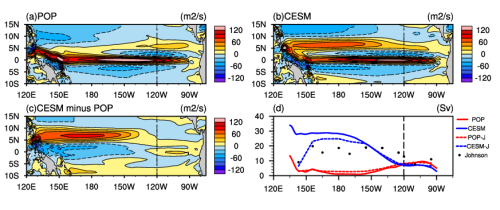The Pacific North Equatorial Countercurrent (NECC) is a major upper-ocean zonal flow of the wind-driven circulation in the tropical Pacific, flowing eastward across the Pacific Ocean basin between 2°N and 10°N. The NECC transport is about 10–30 Sv eastward out of the warm pool region to the relatively cold eastern Pacific on average. It plays important roles in the volume and heat budget of the warm pool and in shaping the tropical Pacific climate.
"The NECC is not well simulated in many ocean models because of its complex dynamics." Said SUN Zhikuo, a Ph.D. candidate in the State Key Laboratory of Numerical Modeling for Atmospheric Sciences and Geophysical Fluid (LASG), at the Institute of Atmospheric Physics, Chinese Academy of Sciences,
In the recent second phase of the Coordinated Ocean-ice Reference Experiments (CORE-II), the NECC simulated in the stand-alone ocean models tend to be weak generally. This problem still exists in the Ocean Model Comparison Program (OMIP) of CMIP6.
"Weak NECC biases will affect the simulation ability of the average status and variability of the tropical surface currents.” According to SUN.
In a recent study published in Journal of Advances in Modeling Earth Systems, SUN and her supervisor Prof. LIU Hailong cooperated with the researchers at Taiwan University and NCAR in the United States and systematically investigated the fundamental causes for the biases.
The team launched three experiments using Community Earth System Model version 2(CESM2) developed at NCAR and then analyzed the dynamic mechanism of NECC.

The upper 400 m vertically integrated zonal currents (Units: m2s-1) for (a) POP with CORE-II forcing, and (b) CESM in the equatorial Pacific. (c) The upper 400 m vertically integrated zonal current difference between CESM and POP. (d) The volume transports of NECC (Unit: Sv), which are defined as the meridionally integrated eastward transport between 3°N-10°N, for POP forced with CORE-II (red solid), CESM (blue solid) and Johnson et al. (2002) observation (black dots). The transports of the NECC masked by the observational sampling are also computed for both POP (red dash) and CESM (blue dash), donated as POP-J and CESM-J. (Image by SUN Zhikuo)
"We found the surface wind stress and its curl is the most important forcing term for correctly simulating the NECC in ocean models. The WSC (wind stress curl) biases come mainly from the zonal wind bias, which may in turn relate to the adjustment of NCEP-NCAR reanalysis actual 10m winds towards satellite equivalent 10m neutral wind from QuikSCAT." SUN said.
Based on the analysis, SUN and her coauthors further identified possible specific causes of wind biases. The problem may arise from the biases in QuikSCAT produce, or misusing of it. Now, they are focusing on the latter, in which the effect of the ocean currents on the computation of momentum flux has been accounted twice during the correction.
"This work provides clues to correcting the common biases of the climate and ocean models. It is expected to effectively improve the simulation ability of the tropical upper circulation in the stand-alone ocean models and reduce the impact of model deviation on climate simulation and prediction." Prof. LIU said. According to him, the work of correcting the biases in the climate ocean models is underway.
Citation: Sun, Z., Liu, H., Lin, P., Tseng, Y.‐H., Small, J., & Bryan, F. (2019). The modeling of the North Equatorial Countercurrent in the Community Earth System Model and its oceanic component. Journal of Advances in Modeling Earth Systems, 11. https://doi. org/10.1029/2018MS001521
Media contact: Ms. LIN Zheng, jennylin@mail.iap.ac.cn
